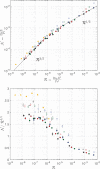Experimental observation of the geostrophic turbulence regime of rapidly rotating convection
- PMID: 34697234
- PMCID: PMC8612362
- DOI: 10.1073/pnas.2105015118
Experimental observation of the geostrophic turbulence regime of rapidly rotating convection
Abstract
The competition between turbulent convection and global rotation in planetary and stellar interiors governs the transport of heat and tracers, as well as magnetic field generation. These objects operate in dynamical regimes ranging from weakly rotating convection to the "geostrophic turbulence" regime of rapidly rotating convection. However, the latter regime has remained elusive in the laboratory, despite a worldwide effort to design ever-taller rotating convection cells over the last decade. Building on a recent experimental approach where convection is driven radiatively, we report heat transport measurements in quantitative agreement with this scaling regime, the experimental scaling law being validated against direct numerical simulations (DNS) of the idealized setup. The scaling exponent from both experiments and DNS agrees well with the geostrophic turbulence prediction. The prefactor of the scaling law is greater than the one diagnosed in previous idealized numerical studies, pointing to an unexpected sensitivity of the heat transport efficiency to the precise distribution of heat sources and sinks, which greatly varies from planets to stars.
Keywords: geophysical and astrophysical fluid dynamics; rotating flows; turbulent convection.
Conflict of interest statement
The authors declare no competing interest.
Figures




Similar articles
-
Radiative heating achieves the ultimate regime of thermal convection.Proc Natl Acad Sci U S A. 2018 Sep 4;115(36):8937-8941. doi: 10.1073/pnas.1806823115. Epub 2018 Aug 22. Proc Natl Acad Sci U S A. 2018. PMID: 30135098 Free PMC article.
-
Heat transport in the geostrophic regime of rotating Rayleigh-Bénard convection.Phys Rev Lett. 2014 Sep 12;113(11):114301. doi: 10.1103/PhysRevLett.113.114301. Epub 2014 Sep 8. Phys Rev Lett. 2014. PMID: 25259983
-
Supergravitational turbulent thermal convection.Sci Adv. 2020 Oct 2;6(40):eabb8676. doi: 10.1126/sciadv.abb8676. Print 2020 Oct. Sci Adv. 2020. PMID: 33008893 Free PMC article.
-
Fluid Dynamics Experiments for Planetary Interiors.Surv Geophys. 2022;43(1):229-261. doi: 10.1007/s10712-021-09681-1. Epub 2021 Dec 10. Surv Geophys. 2022. PMID: 35535259 Free PMC article. Review.
-
The cross-over to magnetostrophic convection in planetary dynamo systems.Proc Math Phys Eng Sci. 2017 Mar;473(2199):20160731. doi: 10.1098/rspa.2016.0731. Epub 2017 Mar 15. Proc Math Phys Eng Sci. 2017. PMID: 28413338 Free PMC article. Review.
Cited by
-
Reynolds number scaling and energy spectra in geostrophic convection.J Fluid Mech. 2023 May 4;962:A36. doi: 10.1017/jfm.2023.326. J Fluid Mech. 2023. PMID: 37323615 Free PMC article.
-
Manipulation of Convection Using Infrared Light Emitted from Human Hands.Adv Sci (Weinh). 2024 Mar;11(12):e2307020. doi: 10.1002/advs.202307020. Epub 2024 Jan 18. Adv Sci (Weinh). 2024. PMID: 38239054 Free PMC article.
References
-
- Schumacher J., Sreenivasan K. R., Colloquium: Unusual dynamics of convection in the sun. Rev. Mod. Phys. 92, 041001 (2020).
-
- Stevenson D. J., Turbulent thermal convection in the presence of rotation and a magnetic field: A heuristic theory. Geophys. Astrophys. Fluid Dyn. 12, 139–169 (1979).
-
- Julien K., Knobloch E., A new class of equations for rotationally constrained flows. Theor. Comput. Fluid Dyn. 11, 251–261 (1998).
Publication types
LinkOut - more resources
Full Text Sources

